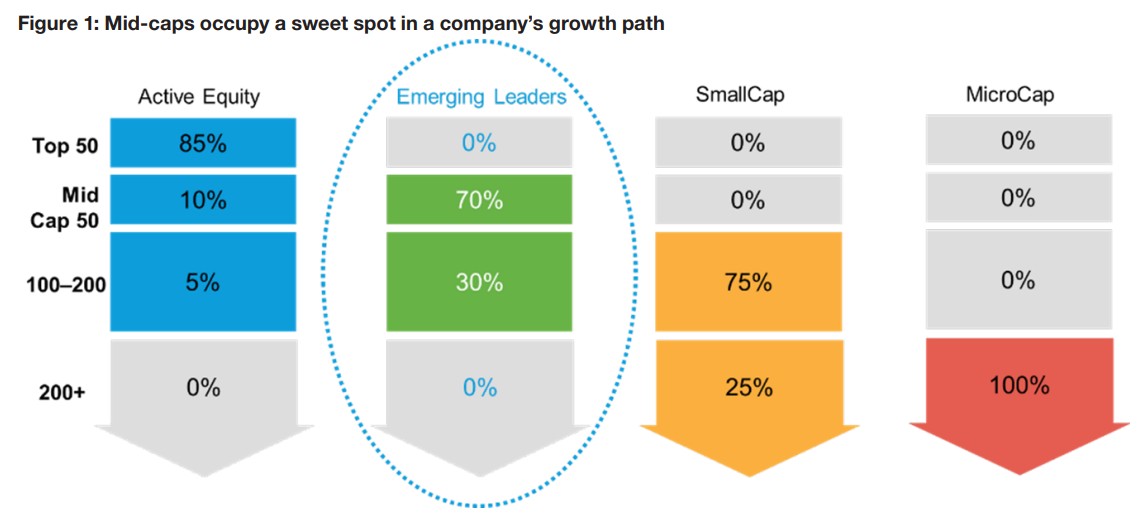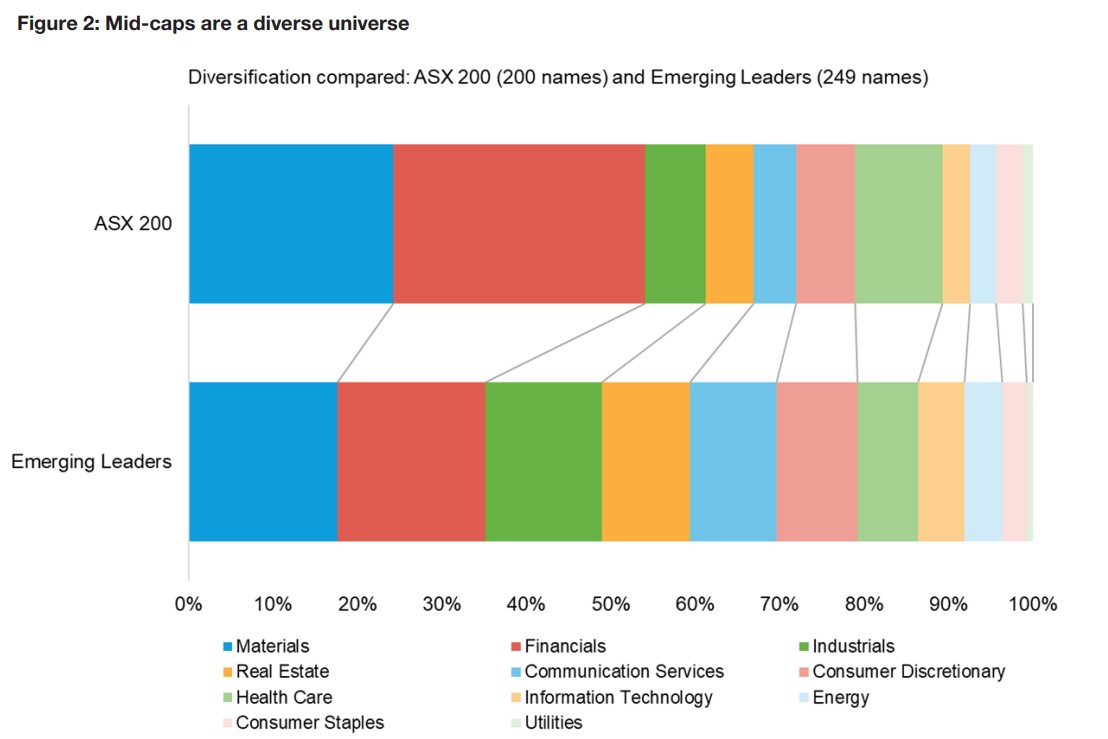Mid-cap edge: Growth runway meets portfolio resilience
Key points
- Mid-cap equities can offer an ‘alpha-rich’ sweet spot of opportunity as companies emerge as leaders in their sectors.
- In many cases, the ‘lion’s share’ of alpha is made from companies that emerge from small-cap status and eventually become large caps.
- Some mid-cap equities offer a balance of dividend and growth opportunities. A catalyst-rich environment adds to earnings growth potential, such as M&A opportunities in the mid-cap space and index rebalancing as companies grow.
- Potential for earnings and growth momentum in mid-caps is usually well above that of larger peers.
Why mid-cap investing is so compelling
We look for those companies accelerating out of the small-cap space on consistently superior earnings growth, where an excellent business model, quality management and execution, rising free cash flow and some pricing power underpin their valuations. The beauty of mid-cap investing is that a lot of the growth path remains, but we have the advantage of knowing how these companies performed when they were small and micro-caps (Figure 1).

The mid-cap sector overlaps part of the ASX 200. How are they different?

What makes the Emerging Leaders’ universe an alpha hotspot?
With respect to the economic cycle, the performance of mid-cap stocks offers longer-term leverage to a growing economy, but less defensiveness. In the recovery and growth phases of the cycle, mid-caps are likely to benefit from stronger sentiment and support, potentially outperforming larger caps.
As the economy enters slowing then contractionary phases, mid-cap companies are more likely to be traded at discounts to larger and more defensive peers, effectively discounted for their exposure to growth.
However, mid-cap companies are seen as less burdened than established players and can be more proactive across the cycle in harnessing growth opportunities, and resetting for the future in slow-growth environments. Overall, a longterm view on positive economic advancement, give or take some recessions and market drawdowns on the way, tends to favour the overall growth path of mid-cap and smaller companies.
Does this mean mid-caps are riskier?
Because of the fundamental analysis we undertake on companies on our Portfolio, we do not consider them riskier propositions than larger cap peers. It is easy to make expensive mistakes at any market cap. In theory, smaller companies are riskier and command a higher risk premium to the risk-free rate to entice investors onto their registers.
This is why over time, with a higher notional growth component to their returns, that mid and small companies outperform larger companies.
There are some key risks that can make smaller companies riskier but which we mitigate in our process to some extent. The first is profitability. We invest in companies that are profitable and with higher levels of free cash flow than the universe average.
We are careful to invest with liquidity in mind so that we do not lose on spreads as we enter, add to and exit positions. Our top-down process helps leverage our macro views into taking careful sector allocation decisions so that we are not fighting the market cycle, even with great companies. Finally, with the integration of ESG in our qualitative assessment of companies, we believe we capture a larger risk set than other investors, helping to mitigate for a wider range of issues.
Themes captured in the Emerging Leaders portfolio
Recently, President Trump’s tariff announcements shocked the market on 2 April, and led to significant volatility and a flight to safety. We have been analysing these tariff changes from a macro perspective. We determined within days of the tariff announcement that the impact, while sharp, would be temporary.
The equity market has since recovered from its ‘Liberation Day’ sell off, and we have benefited from tilts to information technology, financials and in selective materials exposures. Moreover, across the remainder of calendar 2025, we believe US exposed cyclicals should also perform strongly as tariff uncertainty clears, Trump’s deregulation agenda commences, and as the Federal Reserve lowers interest rates.
A key beneficiary based on our outlook is likely to be Reece, an Australian and US plumbing supplies business which should benefit from an improving US housing cycle, continued US store roll-out and improve US store economics. REA Group, well known in Australia for realestate.com.au is also a growing player in the US with realtor.com, and across Asia.
REA has been able to deliver double-digit revenue growth over the past 15-years, a trend we see extending as REA retains a dominant home position and builds on its technology leadership in its expanding global ventures.
We are also seeing significant opportunity in the structural growth in technology. Block is one company where we see significant opportunity, now with 57 million Cash App users globally and growing, capturing US$220bn in point of sale transactions in the US, and processing US$12.5bn annually in buy-now-pay-later transactions. This has seen Cash App deliver 58% CAGR in gross profit since 2018 as Block displaces other financial intermediaries for the business of everyday customers in the US and Australia.
Another tech name we are excited about is Life360. We have been in this name for some time, and we think that there is a significant growth path ahead based on the comparative experience of similar companies. Life360 now has over 44 million monthly average users, more than Duolingo (29m), close to Reddit (48m), and we believe is growing towards the likes of Uber (59m) and Spotify (65m) because of its relevance to the lives of its users.
Life360 offers families and friends a tracking platform for safety, community building, roadside assistance and communication. The service has proved incredibly popular and is set to expand further with innovations in pet and asset tracking. We see major opportunity in the rapid adoption of Life360 by users in the potential for both subscriptions and advertising revenue. Life360 currently earns $0.69 per monthly average user (MAU). Advertising revenue per MAU for Duolingo is around $0.80, with Reddit at $3.32, Spotify at $3.99 and Uber at $6.16. These structural growth companies are relatively inelastic to changes in the economy, making them exciting additions to our thematic exposures.
Read the full paper to discover what sets the Ausbil Australian Emerging Leaders strategy apart and how it’s navigated volatility and delivered over time.
2 topics
1 fund mentioned
.jpg)
.jpg)